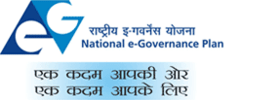National e-Governance Plan
| राष्ट्रीय ई-शासन योजना | |
|
Public Services Closer Home | |
| Abbreviation | NeGP |
|---|---|
| Motto | Public Services Closer Home |
| Formation | May 18, 2006[1] |
| Headquarters | New Delhi |
| Location |
|
Region served | India |
President & CEO (NeGD) | Anoop Kumar Agarwal |
Parent organisation | Department of Electronics and Information Technology |
| Website |
deity |
The National e-Governance Plan (NeGP) is an initiative of the Government of India to make all government services available to the citizens of India via electronic media.[2] NeGP was formulated by the Department of Electronics and Information Technology (DeitY) and Department of Administrative Reforms and Public Grievances (DARPG). The Government approved the National e-Governance Plan, consisting of 27 "Mission Mode Projects" (MMPs) and Tencomponents, on 18 May 2006.[1]
Background
The 11th report of the Second Administrative Reforms Commission, titled "Promoting e-Governance - The Smart Way Forward", established the government's position that an expansion in e-Government was necessary in India.[2] The ARC report was submitted to the Government of India on 20 December 2008.[3] The report cited several prior initiatives as sources of inspiration, including references to the Singapore ONE programme. To pursue this goal, the National e-Governance Plan was formulated by the Department of Information Technology (DIT) and Department of Administrative Reforms & Public Grievances (DAR&PG). The program required the development of new applications to allow citizen access to government services through Common Service Centers; it aimed to both reduce government costs and improve access to services.[4]
E-governance in Punjab
The state Government of Punjab, India has embarked on reform program to modernise its tax administration. The key focus is on improving operational efficiency, enabling voluntary compliance and enhancing tax payer's convenience. The Department has already implemented the project on computerisation of VAT Information System (COVIS) which included designing of a statewide I.T. infrastructure with the central server at Patiala. All Excise and Taxation district offices are linked with the Central Server through leased-lines and V-Sat and formulation of centralised data base. The Department has engaged Ernst & Young as I.T. auditors and CORBUS as Application Software Developer for the Department.The Department has a separate agency known as Excise & Taxation Technical Services Agency (ETTSA) to look after the technical and other modernisation related issued of the department. Current auditor for ETTSA is PWC, but CORBUS is working for ETTSA from 2000 to till date as an application software developer.
Criticism
Lack of needs analysis, business process re-engineering, interoperability across MMPs, and coping with new technology trends (such as mobile interfaces, cloud computing, and digital signatures) were some of the limitations of the initiative.[5]
See also
References
- 1 2 NeGP website. "Approval Details of NeGP". NeGP Website. Retrieved 17 July 2014.
- 1 2 "Second Administrative Reforms Commission Report". Arc.gov.in. Retrieved 2011-03-01.
- ↑ "Second Administrative Reforms Commission Preface to the Report" (PDF). Retrieved 2011-03-01.
- ↑ Indg. "about NeGP". Indg.in. Retrieved 17 July 2014.
- ↑ Revisiting NeGP: eBharat2020:The proposed future NeGP 2.0 by CSR Prabhu in CSI Communications Oct 2011 (access date 5 Mar 2012)
External links
- National eGovernance Website
- Informatics An eGovernance publication from National Informatics Centre
- Saaransh – A compendium of Mission Mode Projects under NeGP
